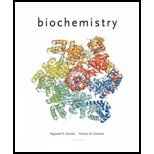
Biochemistry
6th Edition
ISBN: 9781305577206
Author: Reginald H. Garrett, Charles M. Grisham
Publisher: Cengage Learning
expand_more
expand_more
format_list_bulleted
Concept explainers
Textbook Question
Chapter 14, Problem 5P
Answers to all problems are at the end οΓthis book. Detailed solutions are available in the Student Solutions Manual. Study Guide, and Problems Book.
Comparison of Emzymatic and Nonenzymatic Rate Constants
The for alkaline phosphatase—catalyzed hydrolysis of melhylphoiphate is approximately 14/sec at pH 8 and 25ºC. The rate constant for the uncatalyzed hydrolysis of methyl phosphate under the same conditions is approximately I0-15/sec. What is the difference in the free energies of activation of these two reactions?
Expert Solution & Answer
Want to see the full answer?
Check out a sample textbook solution
Students have asked these similar questions
Two tetrapeptides were isolated from a possum's sweat glands. These peptides were sequenced using Edman degradation and the following 2 sequences were obtained:
Gly-Asp-Ala-Leu
Gly-Asp-Asp-Leu
Can you please help show the titration curve for both of these peptides and calculate the PI?
Two tetrapeptides were isolated from a possum's sweat glands. These peptides were sequenced using Edman degradation and the following 2 sequences were obtained:
Gly-Asp-Ala-Leu
Gly-Asp-Asp-Leu
What is the structure of the PTH derivative produced during the last round of amino acid sequencing?
What is the primary sequence of this undecapeptide? Also, if x-ray crystallography shows a highly stable hairpin turn within the polypeptide, what about the primary sequence explains this structural feature?
Chapter 14 Solutions
Biochemistry
Ch. 14 - Answers to all problems are at the end οΓthis...Ch. 14 - Answers to all problems are at the end οΓthis...Ch. 14 - Prob. 3PCh. 14 - Prob. 4PCh. 14 - Answers to all problems are at the end οΓthis...Ch. 14 - Prob. 6PCh. 14 - Prob. 7PCh. 14 - Answers to all problems are at the end οΓthis...Ch. 14 - Answers to all problems are at the end οf this...Ch. 14 - Answers to all problems are at the end οf this...
Ch. 14 - Answers to all problems are at the end of this...Ch. 14 - Answers to all problems are at the end οΓthis...Ch. 14 - Answers to all problems are at the end οΓthis...Ch. 14 - Prob. 14PCh. 14 - Prob. 15PCh. 14 - Prob. 16PCh. 14 - Prob. 17PCh. 14 - Prob. 18PCh. 14 - Answers to all problems are at the end οΓthis...Ch. 14 - Answers to all problems are at the end οΓthis...Ch. 14 - Answers to all problems are at the end οΓthis...Ch. 14 - Prob. 22PCh. 14 - Prob. 23PCh. 14 - Prob. 24PCh. 14 - Prob. 25PCh. 14 - Prob. 26P
Knowledge Booster
Learn more about
Need a deep-dive on the concept behind this application? Look no further. Learn more about this topic, biochemistry and related others by exploring similar questions and additional content below.Similar questions
- Draw the product of this reaction. Ignore inorganic byproducts. H H ⚫OH HO- -H H- -OH H- -OH CH2OH Ag*, NH4OH, H2O Draw Fischer Projectionarrow_forwardDraw the product of this reaction. Ignore inorganic byproducts. H₂O -OH H ⚫OH HO H HO- CH2OH Cu2+ Draw Fischer Projectionarrow_forwardDraw the product of this reaction. Ignore inorganic byproducts. H、 H -OH H ⚫OH H -OH CH2OH Fehlings' solution ⑤ Draw Fischer Projectionarrow_forward
- Draw the product of this reaction. Ignore inorganic byproducts. HO C=0 H ⚫OH H ⚫OH HO- H HO H CH2OH Tollens' solution Draw Fischer Projectionarrow_forwardDraw the product of this reaction. Ignore inorganic byproducts. H-C=O HO H HO H H- ⚫OH HO H CH2OH HNO3, H2O Draw Fischer Projectionarrow_forwardDraw the product of this reaction. Ignore inorganic byproducts. HO HO- HO H HO ∙H HO CH2OH NaBH4, CH3OH Draw Fischer Projectionarrow_forward
- Draw the product of this reaction. Ignore inorganic byproducts. Но сво HO H HO H H OH H -OH CH2OH H2 Pd Draw Fischer Projectionarrow_forwardDraw the Haworth projection for Gulose-ẞ-1,6-sorbose and answer the following questions. (Gulose will be in the pyranose form and Sorbose will be in the furanose form) a. Label the reducing and nonreducing ends of the disaccharide b. Label the glycosidic bond c. Circle the anomeric carbons and label them as hemiacetals or acetals. d. Can this disaccharide undergo mutarotation?arrow_forwardDraw the product of the reaction below. Ignore inorganic byproducts. H OH HO HO HO ·H H OH H OH excess CH3CH2I KOHarrow_forward
- Draw the Haworth structures for the following: a. α-D-Gulopyranose b. ẞ-D-Sorbofuranose c. The two possible isomers of a-D-altrose (furanose and pyranose forms)arrow_forwardDraw the product of this reaction. Ignore inorganic byproducts. HO H ⚫OH HO- ∙H H- -OH H ⚫OH CH2OH HNO3, H2Oarrow_forwardDraw the product of the reaction below. Ignore inorganic byproducts. HO CH2OH OH OH OH excess CHзI Ag2Oarrow_forward
arrow_back_ios
SEE MORE QUESTIONS
arrow_forward_ios
Recommended textbooks for you
 BiochemistryBiochemistryISBN:9781305577206Author:Reginald H. Garrett, Charles M. GrishamPublisher:Cengage Learning
BiochemistryBiochemistryISBN:9781305577206Author:Reginald H. Garrett, Charles M. GrishamPublisher:Cengage Learning

Biochemistry
Biochemistry
ISBN:9781305577206
Author:Reginald H. Garrett, Charles M. Grisham
Publisher:Cengage Learning
Chapter 7 - Human Movement Science; Author: Dr. Jeff Williams;https://www.youtube.com/watch?v=LlqElkn4PA4;License: Standard youtube license